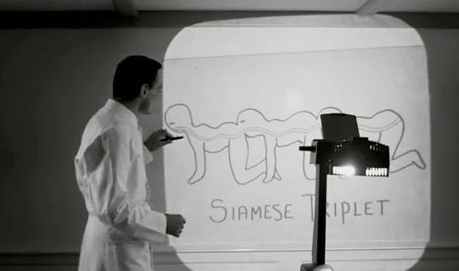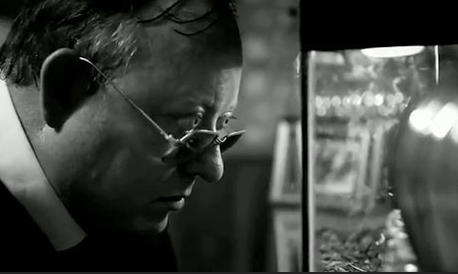Pythagoras called the number 3 the "noblest" of all digits, the only number to equal the sum of its preceding terms. There is a culminating symmetry in the simple sequence--1, 2, 3--a narrative and spiritual satisfaction which explains the popularity of trinities and trilogies. 1 and 2 cry out for crowning climax: the noble triad, the charm of triplets, the full sequence. In the case of the epic cinematic triptych, The Human Centipede saga, the elegant metaphor of mathematics has never been more apt.
Many critics have written off the conceit as a crass, offensive exercise in the torture-porn genre to which high-grossing series like Hostel and Saw have given commercial legitimacy. But this dismissal misses the twisted brilliance of the concept, which fuses the terrors of mysophobia (fear of germs), hydrophobia (fear of drowning), claustrophia, and metamorphosis into a punishment worthy of Dante's Inferno. The First Sequence has a satirically B-grade horror flick structure: two beautiful, pampered, foolish young women traveling through Germany abandon their car with flat tire and tromp through the rainy woods in search of help. Instead they find the home of Dr. Josef Heiter, a former specialist in separating conjoined twins whose evil fantasy is to perform the opposite operation on three wretched individuals. Dr. Heiter's surgical precision, the sterility of his underground laboratory, evoke the disinfectant-smelling dread of hospitals and Nazi operating rooms--where Jews and other unfortunates were sewn together into grotesque conjunctions.

The concluding chapter of Dutch director Tom Six's visionary nightmare--The Human Centipede 3: Final Sequence--is due for release sometime this year. The eccentric director has announced tantalizingly little about the plot: it takes place in a prison in the American desert, and features an eponymous creature of exponential proportions. The film stars Eric Roberts (Best of the Best I and II, The Dark Knight Returns), and also Dieter Laser and Laurence R. Harvey who respectively played the sadistic centipede-creators in The Human Centipede part 1 and 2. The casting of the first two villains reinforces the third installment's sum-of-its-parts culmination, and the meta connection from film to film to film. What else might we expect from the ghoulish conclusion?
1. Can it be done? The Human Centipede 2: Full Sequence was not only a sequel to The Human Centipede 1, but an expansion of dimension. It takes place in a grainy, black-and-white David Lynchian world in which The Human Centipede is indeed a well-known film. Martin, a toadish parking garage attendant, is a Human Centipede superfan who embodies the fear every horror movie director must face: what if some lunatic goes out and copycats your premise? Martin is that lunatic, who yearns to make a centipede, a subjugated pet, of his own. The cult success of these two films, First Sequence and Full Sequence, have cemented the concept of the Human Centipede into our popular consciousness. It's become a Halloween costume, a joke, a kind of urban legend, a source of debate. The Human Centipede 3 should acknowlege this, continuing the Russian doll film-within-a-film configuration. In the Final Sequence, the central question of the first two HC films--Is it possible to conjoin three people, anterior to posterior, into a single functioning organism?--has become a source of controversy among online fan-clubs. Followers of the horror saga are curious, and their curiosity demands a medically accurate answer.
2. Yes it can: The wretched creature assembled into existence in The Human Centipede 3, then, will likely be a response to this perverse question. A demented attempt to prove that, yes, it is possible. But proving something requires recognition. So in the Final Sequence, the entire surgical and rehabilitation process would be documented on film and broadcast across the internet, like an underground snuff website. Gradually the footage might reach the general public's attention. The source of the broadcast--the location of the centipede-creators--would be scrambled to elude the authority's investigation. The world would watch in helpless fascination as a human centipede was born.
3. Live! Live! But it's not enough to simply birth the beast. The clinical Dr. Heiter in The Human Centipede 1 and the reptilian Martin in The Human Centipede 2 both succeed in assembling a human centipede, which suffers its hellish existence for a mercifully short period of time before disintegrating. Any psychopath with a staple gun and a roll of duct tape can make a human centipede. No, the trick is keeping it alive. Long enough for the scars to heal, for the flesh to fuse together. For the monstrosity to get the hang of its serpentine scuttle across the floor. The unsavory matter of ingestion and digestion could be chemically regulated, nutritional supplements delivered via IV. It would simply exist, a "healthy," miserable organism. The First Sequence dreamed by mad Dr. Heiter, the renowned separator of congenital twins, would attain its awful apotheosis.
4. A little help from my friends: One twisted individual could not do this on his/her own, of course. An experiment of this complexity would take a whole team. A small crew of specialists, each overseeing a particular niche in the centipede's development. Such a collection of scientists could certainly be operating within the confines of a high-security prison in the desert. In fact, a remote prison would be the ideal laboratory setting: guarded from the public eye, with steady access to limitless test subjects discarded by society, and mantled in state-sanctioned respectability. Who knows what appalling corruptions are perpetuated in prisons, packed with our rejects, out of sight and mind?
5. So happy together: In the end of The Human Centipede 3, the scrambled broadcast signal would eventually be deciphered. The authorities descend, the evil scientists are killed or captured, the human centipede is "rescued." But it is too late. The metamorphosis is complete, the fusion far deeper than the flesh. The most hauntingly poignant scene in the First Sequence was of the three abject victims in their cage at night, shivering and whimpering and reaching to hold each other's hands. They are bonded in their plight, three dreamers locked in mutual nightmare. But over time, the nightmare becomes normality, the inconceivable becomes familiar and--finally--desirable, like a form of Stockholm Syndrome. As the victims in the prison laboratory have healed and grown accustomed to their strange existence, their minds have increasingly melded together. By the time they are saved, they no longer think of themselves as "I." They are the human centipede. Surgically separated, rendered individuals, they are isolated and lost. In spite of their autonomous instincts, they yearn--like Siamese twins, like a band split asunder--to be back together again.



